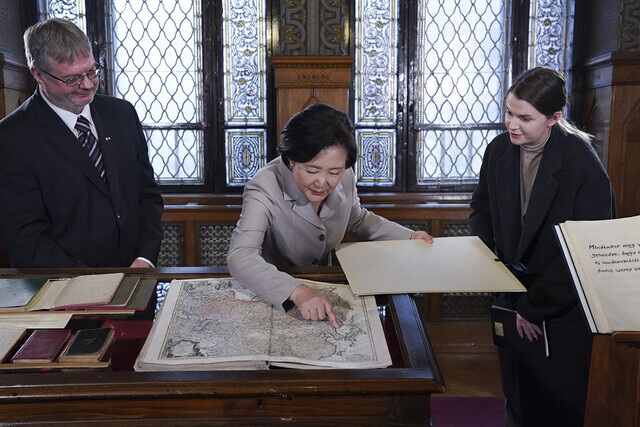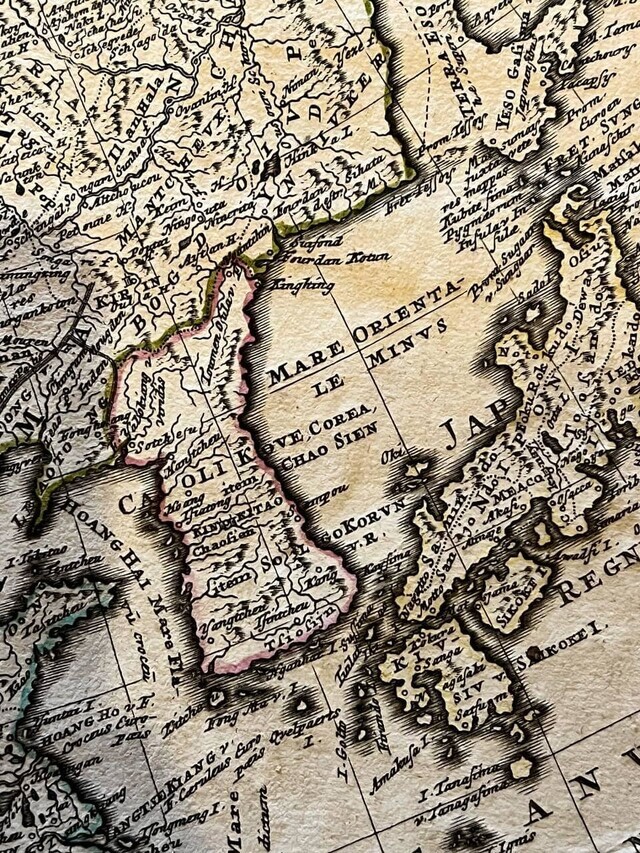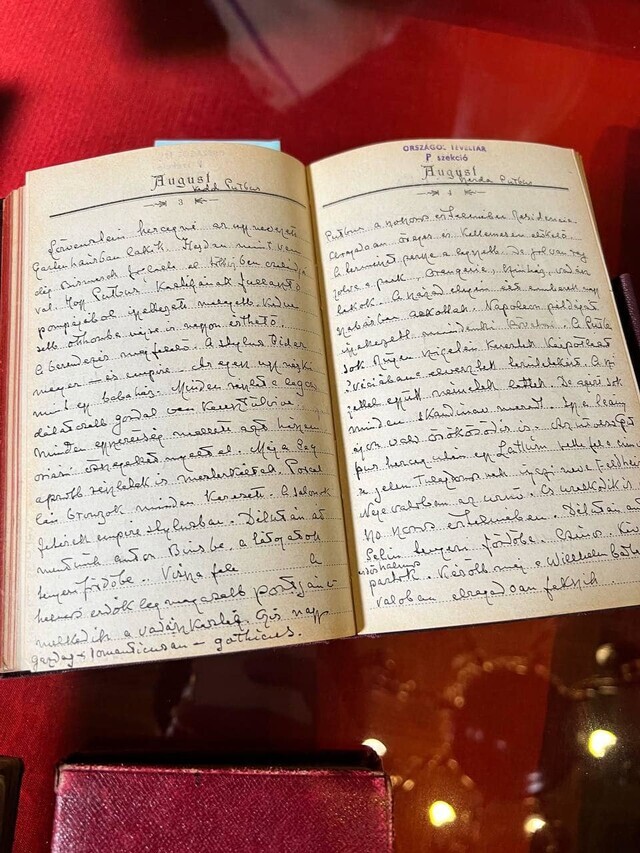hankyoreh
Links to other country sites 다른 나라 사이트 링크
First lady thanks Hungary for sharing 18th-century map denoting East Sea

While visiting the National Archives of Hungary on Wednesday, South Korean first lady Kim Jung-sook was given a copy of an 18th-century European map that labels the sea off the eastern coast of the Korean Peninsula with the Latin phrase “MARE ORIENTALE MINVS,” meaning “Small East Sea.” Kim was on a state visit to Hungary with her husband, President Moon Jae-in.
“Korea is identified here as ‘CAOLI KUO, COREA, CHAO SIEN,’” said Blue House spokesperson Park Kyung-mee on Thursday, while viewing the map she’d received from the first lady.
“This map, which was produced in Europe in 1730, shows that the sea on the eastern side of the Korean Peninsula was regarded as the ‘East Sea’ in 18th century Europe,” Park added.
That body of water is often called the “Sea of Japan,” but Korea has campaigned for international maps to also label it as the “East Sea.”

Officials from the Hungarian and Korean national archives explained that the map was particularly rare and valuable because it came from the 1730 first printing, rather than the 1739 edition, of which more copies have survived.
After reading “Small East Sea,” labeled on the map, Kim said, “Thank you for giving us such a truly rare item.”
Kim also complimented researchers from both countries’ national archives for unearthing documents linking the two amid the extensive of records at the National Archives of Hungary.
Korea and Hungary’s national archives used the occasion to sign a memorandum of understanding about cooperation on record storage.
By presenting the Korean first lady with this old European map that lists the “Small East Sea,” Hungary may have been seeking to promote economic and diplomatic cooperation with Korea.
When Moon paid a visit to Spain in June, he had a chance to view an old map at the Spanish senate library called “Royaume de Coree” (Kingdom of Korea), dating to 1730. The map represents Ulleung Island and the Dokdo islets, both off Korea’s eastern coast, as belonging to Korea.

Another notable part of Kim’s visit to the National Archives of Hungary was the viewing of a 1902 diary and 1918 book by Count Peter Vay, a Hungarian priest who recorded his impressions of Korea while doing missionary work there.
“[Japan’s] brutality has made Koreans’ resistance even stronger. Japan’s measures could serve to awaken a sense of pride in the Korean people. There’s no doubt that the Korean people are superior to the invaders. The Koreans could learn from and surpass the Japanese and eventually regain their sovereignty,” Vay wrote.
“I’ve already written that Busan will serve as a gate to the continent of Asia because of its special geopolitical location. Busan is a link in a great chain that begins in Europe and passes through Siberia, Central Asia and Japan on its way to the United States. All express trains departing Paris and Saint Petersburg for Asia head toward Busan. Busan today is the actual terminus, the endpoint of the long journey linking Europe and Asia,” the priest also wrote.
“That felt like traveling a hundred years into the past,” remarked Kim, after reading these passages aloud with Csaba Szabo, director of the National Archives of Hungary.
“[Vay] perfectly foretold the Republic of Korea’s vision of reconnecting the railroad links with North Korea that have been severed since the peninsula’s division and connecting us to Russia and Europe. The future of Korea that Vay envisioned at its darkest hour has become our reality,” Kim said.
By Lee Wan, staff reporter
Please direct questions or comments to [english@hani.co.kr]

Editorial・opinion
![[Column] Life on our Trisolaris [Column] Life on our Trisolaris](https://flexible.img.hani.co.kr/flexible/normal/500/300/imgdb/original/2024/0505/4817148682278544.jpg) [Column] Life on our Trisolaris
[Column] Life on our Trisolaris![[Editorial] Penalties for airing allegations against Korea’s first lady endanger free press [Editorial] Penalties for airing allegations against Korea’s first lady endanger free press](https://flexible.img.hani.co.kr/flexible/normal/500/300/imgdb/original/2024/0502/1817146398095106.jpg) [Editorial] Penalties for airing allegations against Korea’s first lady endanger free press
[Editorial] Penalties for airing allegations against Korea’s first lady endanger free press- [Editorial] Yoon must halt procurement of SM-3 interceptor missiles
- [Guest essay] Maybe Korea’s rapid population decline is an opportunity, not a crisis
- [Column] Can Yoon steer diplomacy with Russia, China back on track?
- [Column] Season 2 of special prosecutor probe may be coming to Korea soon
- [Column] Park Geun-hye déjà vu in Yoon Suk-yeol
- [Editorial] New weight of N. Korea’s nuclear threats makes dialogue all the more urgent
- [Guest essay] The real reason Korea’s new right wants to dub Rhee a founding father
- [Column] ‘Choson’: Is it time we start referring to N. Korea in its own terms?
Most viewed articles
- 1New sex-ed guidelines forbid teaching about homosexuality
- 260% of young Koreans see no need to have kids after marriage
- 3Months and months of overdue wages are pushing migrant workers in Korea into debt
- 4Presidential office warns of veto in response to opposition passing special counsel probe act
- 5[Column] Life on our Trisolaris
- 6S. Korea discusses participation in defense development with AUKUS alliance
- 7OECD upgrades Korea’s growth forecast from 2.2% to 2.6%
- 8Japan says it’s not pressuring Naver to sell Line, but Korean insiders say otherwise
- 9Opposition calling for thorough investigation into Pres. Park’s unelected power broker
- 10Ruling and opposition parties agree to special prosecutor for Pres. Park/Choi Sun-sil scandal